Select Language
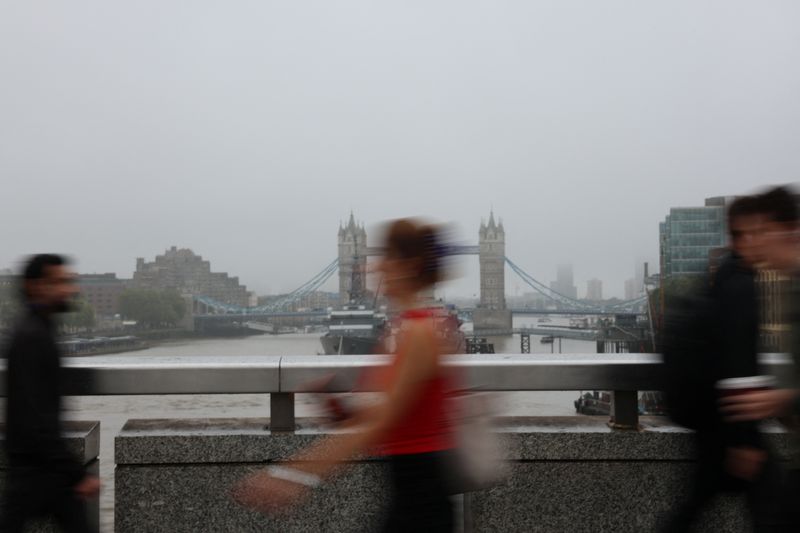
LONDON (Reuters) - Pay settlements awarded by British employers held at their lowest in two years in the three months to August, according to a survey that could reassure the Bank of England as it considers whether to cut interest rates again.
Incomes Data Research said on Wednesday that the median pay settlement awarded by major employers held at 4.0% for the second month in a row.
Median pay awards in the public sector stood at 4.5%, above those in the private sector which slowed to 4.1%.
"The differing outcomes in the private and public sectors reflect the cycle of pay between the two, with the public sector currently in the 'catching-up' phase, after a lengthy period in which pay awards lagged behind those in the private sector," Zoe Woolacott, senior researcher at IDR, said.
Finance minister Rachel Reeves announced above-inflation pay increases worth 9.4 billion pounds ($12.53 billion) for public sector workers including teachers and doctors shortly after the Labour Party won a parliamentary election in July.
Official figures last month showed British private sector wage growth cooled to a more than two-year low of 4.9% in the three months to July.
The BoE is monitoring wage growth, and expects private-sector pay to slow to 3% in late 2025.
The central bank, which cut its key Bank Rate in August for the first time since 2020 but kept it at 5% on Sept. 19, is expected to lower borrowing costs by a further quarter point at its November meeting.
The IDR analysis was based on 39 pay deals which covered more than 740,000 workers between June 1 and Aug. 31.
($1 = 0.7505 pounds)
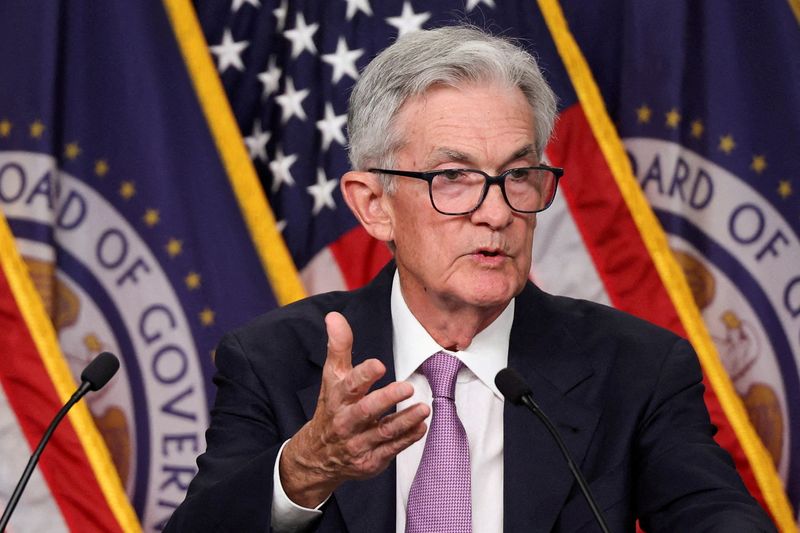
By Howard Schneider
NASHVILLE, Tennessee (Reuters) - A mistake by the U.S. central bank in setting interest rates during the last phase of its inflation battle is the main risk that could undercut the economy over the next year, according to a new survey of economists released as Federal Reserve Chair Jerome Powell was set to speak on Monday.
Among 32 professional forecasters surveyed recently by the National Association for Business Economics, 39% cited a "monetary policy mistake" as the "greatest downside risk to the U.S. economy over the next 12 months." By contrast, 23% regarded the outcome of the Nov. 5 U.S. presidential election as the biggest downside risk and the same number cited an intensification of the conflicts in Ukraine and the Middle East.
The responses in the survey, which was released on Sunday, show the intense focus on the Fed as it eases monetary policy while hoping to both keep inflation on a steady decline back to its 2% target and avoid a significant additional rise in an unemployment rate that has been increasing modestly for a year.
Powell is scheduled to address the association at 12:55 p.m. CDT (1755 GMT) in Nashville, Tennessee, and is expected to elaborate on the Fed's decision to cut its benchmark interest rate by half a percentage point at its Sept. 17-18 meeting and on the considerations that will frame an expected series of reductions in borrowing costs over the rest of this year and in 2025.
The Fed is expected to cut rates again, either by a quarter or half of a percentage point, at its Nov. 6-7 policy meeting.
Overall risks to the economy are increasing, the association's panel of economists indicated, with 55% saying it was more likely the economy would perform worse than expected than do better - with Fed policy topping the list of possible speed bumps.
As it stands, the panel at the median said U.S. economic growth is expected to slow to 1.8% next year, from an estimated 2.6% this year, with the unemployment rate rising to 4.4%, from the current 4.2%, and inflation ending next year at 2.1%.
Two-thirds of respondents said they did not expect a recession until at least 2026.
'JUST IN TIME'
Such results would likely be cheered by Powell and the Fed as a textbook "soft landing." Inflation, as measured by the central bank's preferred personal consumption expenditures price index, has fallen from a peak above 7% in 2022 to 2.2% last month without a recession or a sharp rise in the unemployment rate. While the jobless rate has risen to 4.2% from half-century lows last year of 3.4%, it remains well below the average of 5.7% recorded in Bureau of Labor Statistics data since the late 1940s.
But there's broad disagreement about how to finish the job, highlighting concerns about the Fed's ability to avoid either keeping borrowing costs and financial conditions too tight, and slowing the economy unnecessarily, or loosening so quickly that inflation rebounds.
While the median of the panel's forecasters said the current policy rate is where it should be following the Fed's recent rate cut, opinion was roughly split on that issue - with a majority feeling the central bank is already off track.
The rate move came "just in time," 65% of the respondents said.
But only one-third of them believe the current policy rate is "just right," while another third "believe the rate should be less than 4.75% and 30% believe it should be 5% or higher," the survey showed.
Among other risks cited, respondents were divided over what election outcome posed the greater threat to the economy.
Having control of Congress and the White House in the hands of one party can make decision-making smoother on issues like lifting the debt ceiling or setting a budget, but can also give a president more leeway to act on campaign promises, such as tax cuts or trade policies.
As a negative risk, 13% said a Republican sweep of the White House and Congress would pose a threat, compared to 10% who felt that way about a Democratic sweep of the executive and legislative branches of government.
By contrast, 7% of respondents viewed a Democratic or Republican sweep in a positive light.
Divided government was seen as a downside risk by 17% of respondents and an upside risk by 13%.
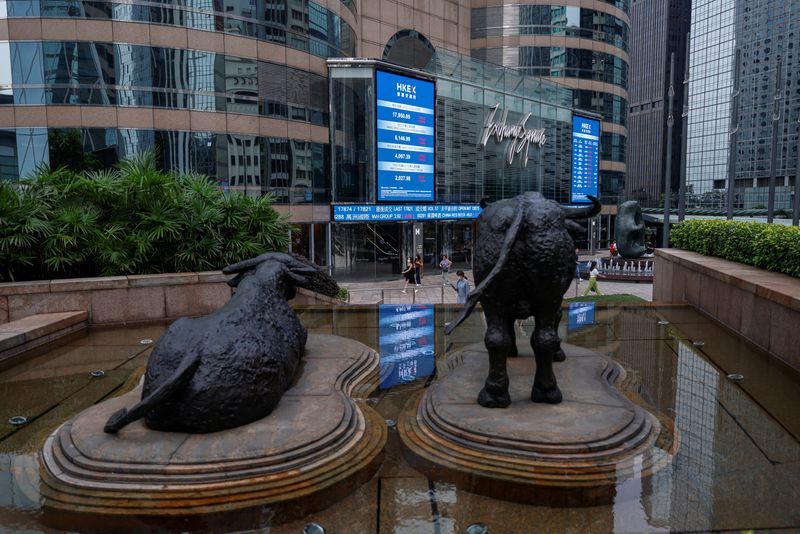
SHANGHAI/SINGAPORE (Reuters) - Chinese stocks extended a blistering rally on Monday with those in the mainland headed for their best month in almost a decade, as Beijing rolled out further stimulus measures to arrest a slowdown in the broad economy.
Benchmark indexes in mainland China began the week on a solid footing after clocking their best weekly performance in nearly 16 years on Friday, with the CSI300 blue-chip index last up more than 6.22%.
The Shanghai Composite Index jumped 5.7%, while Hong Kong's Hang Seng Index rose 3.34%.
Shares of property companies rose sharply in response to China's central bank late on Sunday saying that it would tell banks to lower mortgage rates for existing home loans before Oct. 31, as part of sweeping policies to support the country's beleaguered property market.
Adding to efforts to reverse the property downturn, Guangzhou city announced the same day the lifting of all restrictions on home purchases, while Shanghai and Shenzhen eased curbs on buying.
"The market is still surprised by China's policy support and momentum is still continuing," said Kenny Ng, strategist at China Everbright (OTC:CHFFF) Securities International in Hong Kong.
Mainland-listed property stocks advanced 6.4%, while the Hang Seng Mainland Properties Index charged 8.4% higher.
Shares of consumer staples last traded 7% higher. The smaller Shenzhen index soared 8.2%.
For the month, the CSI300 index was eyeing a gain of more than 18%, its best performance since December 2014. The Shanghai Composite Index was similarly on track to end September with a 14.8% increase, its most since April 2015.
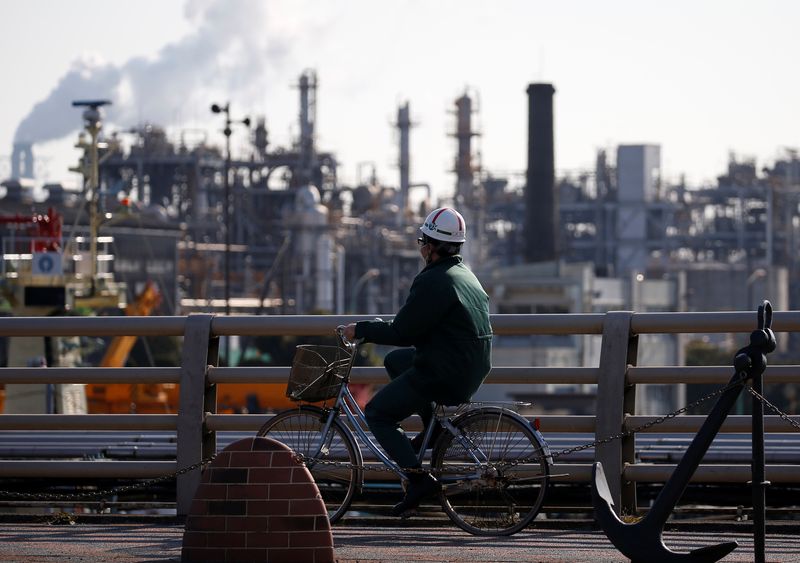
By Satoshi Sugiyama
TOKYO (Reuters) -Japan's factory output tumbled last month driven by typhoon-led disruptions in motor vehicle production and weak U.S. sales, with the government and analysts cautioning about a subdued outlook that raises the hurdle for a solid economic recovery.
Industrial output fell 3.3% in August from the previous month, data released by the Ministry of Economy, Trade and Industry (METI) on Monday showed, worse than a median market forecast for a 0.9% drop.
"Taking into account overseas factors, it is difficult to expect a significant increase in production in the near future, and the pace of recovery will remain moderate," said Shungo Akimoto, market economist at Mizuho Securities.
Motor vehicles production dropped 10.6% in August compared to a month ago, as Typhoon Shanshan forced a swath of automakers to suspend operations, a METI official said. Automaker's certification scandals, which led to the production suspension of three models domestically, also put downward pressure on output.
Weak auto sales in the U.S. might have also dented motor vehicle output, said Takeshi Minami, chief economist at Norinchukin Research Institute.
Production machinery also fell, including a chip-making machinery down sharply by 18.7% month-on-month in August. The METI attributed the decrease to weaker overseas demand, with exports to Taiwan dropping significantly.
Although manufacturers surveyed by METI expect seasonally adjusted output to increase 2.0% in September and expand 6.1% in October, those production forecasts tend to come out stronger than the actual results.
The July-September output would be lower than the second quarter even if September output grows as anticipated, a METI official said.
"The weight on production was gradually being lifted, but there was a strong sense of uncertainty when we thought about whether we could have a bright outlook in the future," the official said.
Separate data showed Japanese retail sales rose 2.8% in August from a year earlier, above the median market forecast for a 2.3% rise.
Compared with the previous month, retail sales edged up 0.8% in August, following a 0.2% gain in July, the data showed.
Japan's economy expanded an annualised 2.9% in the second quarter as steady wage hikes underpinned consumer spending. Capital expenditure continues to grow, though soft demand in China and slowing U.S. growth cloud the outlook for the export-reliant country.
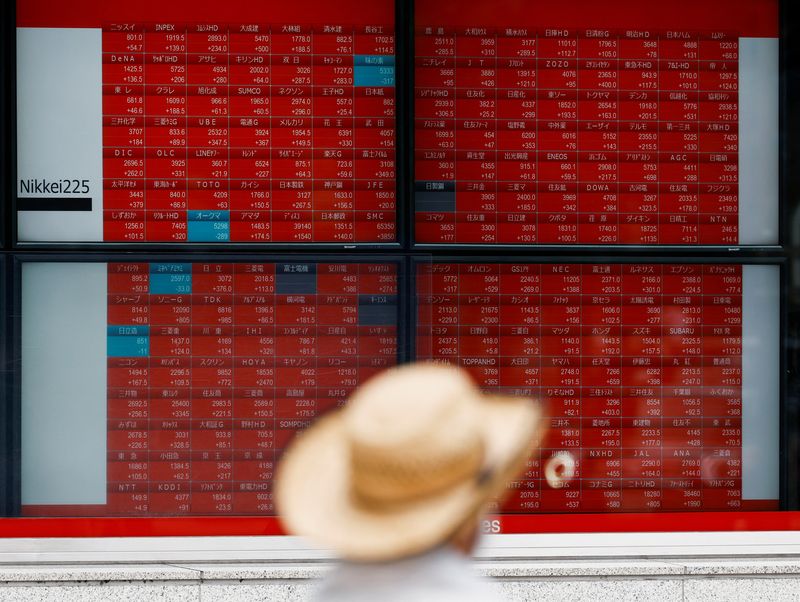
By Wayne Cole
SYDNEY (Reuters) -Asia share markets turned hesitant on Monday as strife in the Middle East offset more stimulus measures in China, while the Nikkei dived on concerns Japan's new prime minister favoured normalising interest rates.
The rush of stimulus helped outweigh a poor manufacturing survey and lift the blue-chip CSI300 another 3.0%, having already jumped 16% last week. The Shanghai Composite climbed 4.4%, on top of last week's 13% rally.
Continued Israeli strikes across Lebanon added geopolitical uncertainty to the mix, though oil prices were still restrained by the risk of increased supply. [O/R]
The week is packed with major U.S. economic data including a payrolls report that could decide whether the Federal Reserve delivers another outsized rate cut in November.
The Nikkei led the early action with a dive of 4.1% as investors anxiously waited for more direction from new Prime Minister Shigeru Ishiba, who has been critical of the Bank of Japan's easy policies in the past.
However, he sounded more conciliatory over the weekend saying monetary policy "must remain accommodative" given the state of the economy.
That helped the dollar nudge up 0.2% to 142.52 yen, after sliding 1.8% on Friday from a 146.49 top. [USD/]
"Ishiba has endorsed the BoJ's intention to normalise monetary policy, albeit leaving it uncertain as to the pace and timing," said HSBC economist Jun Takazawa.
"If additional stimulus measures are realised, this would also likely buttress the recovering trend in spending, thereby strengthening the BoJ's conviction to raise interest rates at a gradual pace," he added. "All in all, we continue to see a constructive outlook for Japan."
Over in China, the central bank said it would tell banks to lower mortgage rates for existing home loans by the end of October, likely by 50 basis points on average.
That follows a barrage of monetary, fiscal and liquidity support measures announced last week in Beijing's biggest stimulus package since the pandemic.
"We believe deflation risks are now being taken more seriously," said Christian Keller, head of economic research at Barclays. "At the same time, the Politburo suggests a consensus has likely been reached in Beijing that fiscal stimulus and central government leverage are necessary to arrest the downturn."
"This is an important shift in a market that was looking for more than just the bare minimum."
WALL ST ON A ROLL
The rally in China helped MSCI's broadest index of Asia-Pacific shares outside Japan firm 0.3%, having surged 6.1% last week to a seven-month high.
Wall Street also had a rousing week helped by a benign reading on core U.S. inflation on Friday that left the door open to another half-point rate cut from the Fed.
Futures imply around a 53% chance the Fed will ease by 50 basis points on Nov. 7, though the presidential election two days earlier remains a major unknown.
A host of Fed speakers will have their say this week, led by Chair Jerome Powell later on Monday. Also due are data on job openings and private hiring, along with ISM surveys on manufacturing and services.
EUROSTOXX 50 futures FTSE futures were little changed in early trade. S&P 500 futures were flat on Monday, while Nasdaq futures dipped a fraction. The S&P 500 index is up 20% year-to-date and on track for its strongest January-September performance since 1997.
In currency markets, the dollar index was flat at 100.41 after easing 0.3% last week. The euro stood at $1.1167 , having bounced on Friday in the wake of the benign U.S. inflation report. [USD/]
The euro zone releases its inflation figures this week, along with producer prices and unemployment. German inflation and retail sales are due later on Monday, while European Central Bank President Christine Lagarde speaks to parliament.
A softer dollar combined with lower bond yields to help gold reach record highs at $2,685 an ounce. It was last at $2,656 an ounce, and on track for its best quarter since 2016. [GOL/]
Oil prices crept higher at tensions in the Middle East offset concerns about possible increased supply from Saudi Arabia. [O/R]
Brent rose 61 cents to $72.59 a barrel, while U.S. crude gained 44 cents to $68.60 per barrel.
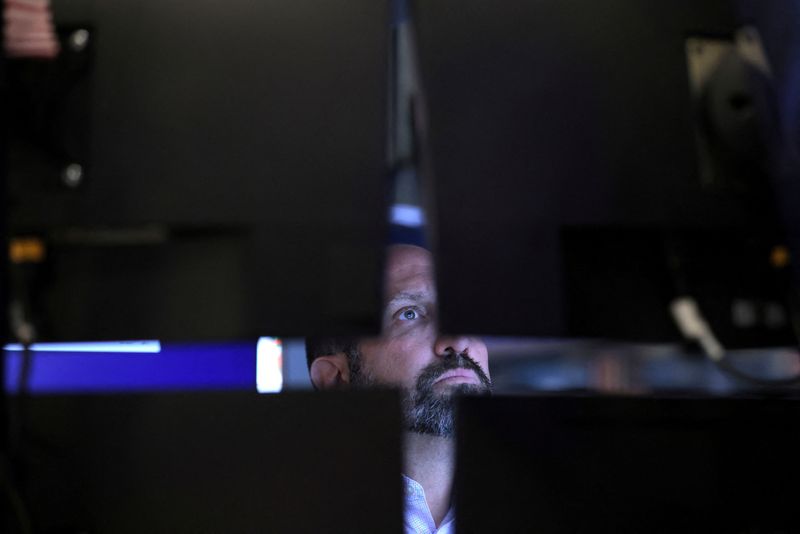
Investing.com -- Investors may get some indications about the size of the next Federal Reserve rate cut this week as the latest US jobs report is released and Fed Chair Jerome Powell speaks. Meanwhile, the final quarter of what has been a turbulent year so far in markets gets underway. Here's your look at what's happening in markets for the week ahead.
1. US jobs report
The Fed kicked off its rate-cutting cycle with a super-sized 50 basis point cut earlier this month, but the labor market continues to be a focal point for investors gauging how rapidly the central bank will need to cut rates in coming months.
The Labor Department is to release the October nonfarm payrolls report on Friday, with economists expecting the US economy to have added 144,000 jobs.
Investors are keen to see whether the jobs data will support expectations for a soft-landing scenario, in which the Fed tames inflation without badly impacting growth.
Weaker than expected data could revive fears over the prospect of a recession, while unexpectedly strong jobs growth may stir worries that the Fed will not cut rates as deeply as expected as it seeks to avoid an inflation flare-up.
2. Powell remarks
Fed Chair Jerome Powell is set to speak on the economic outlook before the National Association for Business Economics on Monday.
In a note dated Friday, analysts at Deutsche Bank said they expect Powell's comments to largely echo his post-meeting press conference remarks, where he justified the outsized rate cut by the confidence gained on inflation and the clear shift in downside risks, particularly to the labor market.
Investors will also get the chance to hear from several other Fed officials over the course of the week, including regional Fed presidents Bowman, Bostic, Barkin and Williams.
Ahead of Friday’s jobs report Tuesday's JOLTS report for August and Wednesday's ADP data on private sector hiring will give a broad outlook on the state of the labor market.
3, Q4 kicks off
The fourth quarter gets underway on Tuesday after a turbulent few months in markets.
August was a volatile month with the unwinding of the yen carry trade coming at almost exactly the same time that the Mag 7 tech bulls broke down and recession fears flared after a weaker than expected US jobs report.
Stocks have since rallied to fresh record highs, but the yen is about to clinch its best quarterly performance since the 2008 global financial meltdown, benchmark global borrowing costs and oil are both down almost 15% and China is opening the stimulus spigots.
The final quarter will be dominated by November's US election between Donald Trump and Kamala Harris so more volatility is likely in store.
4. Eurozone inflation
The eurozone is to release flash September inflation data on Tuesday, which will be closely watched as European Central Bank officials mull whether to cut rates again in October.
Economists are expecting the annual rate of inflation to come in at 1.9%, dropping below the ECB’s 2% target for the first time since June 2021 thanks to lower energy prices, though it's expected to rise again in the final months of the year.
Investors are now pricing in a slightly more than 50% chance of a 25 basis-point October rate cut they thought was unlikely just last week as euro zone business activity unexpectedly contracted in September, stoking fears the ECB is behind the curve.
5. Oil prices
Oil prices settled higher on Friday but fell on the week as investors weighed expectations for higher global supply against fresh stimulus from top crude importer China.
On a weekly basis, Brent settled down around 3%, while crude futures fell by around 5%.
China's central bank on Friday announced fresh stimulus measures aimed at bringing economic growth back toward this year's target of roughly 5%.
But concerns about oversupply weighed following reports that the Organization of the Petroleum Exporting Countries and its allies, together known as OPEC+, will go ahead with plans to increase production by 180,000 bpd each month starting from December.
Heightened tensions in the Middle East, raising the risk of supply disruption, continued to underpin the oil market.
Energy traders will be looking closely at labor market data in the coming days as interest rate cuts typically boost economic activity and energy demand.
--Reuters contributed reporting
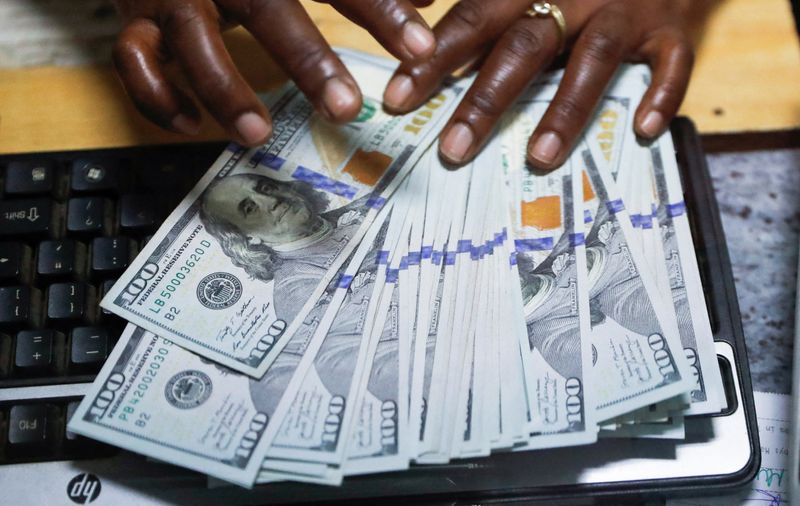
By Ankur Banerjee
SINGAPORE (Reuters) -The yen slid on Friday as investors awaited results from a run-off in Japan's contest to replace its prime minister, while China's spree of stimulus measures kept risk-sensitive currencies aloft.
The yen fell more than 1% to 146.495, its lowest since Sept. 3, with markets bracing for the victory of hardline nationalist Sanae Takaichi, a vocal opponent of further interest rate hikes, in one the country's most unpredictable leadership votes in decades.
Out of a record nine-strong field, economic security minister Takaichi and former defence minister Shigeru Ishiba, amassed the most votes and qualified for the second round expected to conclude at 0630 GMT.
"If Takaichi wins and dollar/yen goes back to 160, markets might see an earlier BOJ hike or FX interventions again, although with top currency diplomat Kanda gone those might be a lot less punchy than previously," UBS analysts said in a note.
Meanwhile, China's spree of stimulus measures this week continued to boost risk appetite, lifting stocks, commodities and risk-sensitive currencies.
Steps so far have included lowering the amount of cash banks must hold as reserves by 50 basis points to free up more funds for lending and a slew of cuts in key interest rates.
Sterling was a shade lower at $1.3381 but remained close to the 2-1/2 year high it touched this week, while the Australian and New Zealand dollars also held near multi-year highs due to China stimulus plans.
The Aussie eased to $0.68705, but was near the 18-month high it touched on Wednesday. The kiwi last fetched $0.6298, not far from its nine-month high. [AUD/]
On Thursday, China's leaders pledged to support the struggling economy through "forceful" interest rate cuts and adjustments to fiscal and monetary policies, stoking expectations for more stimulus.
The remarks, which included guidance to officials to support household consumption and stabilise the troubled real estate market, came in an official summary of a monthly meeting of top Communist Party officials, the Politburo.
"It certainly appears that property and the economy have become an urgent priority for the Politburo judging by the timing of the announcements and the specific mention of fiscal measures," said Jon Withaar, who manages an Asia special situations hedge fund at Pictet Asset Management.
"We are positive on the change in language but want to see specific details to be able to make a informed decision about the efficacy of such measures."
DRIFTING DOLLAR
Data on Thursday suggested the U.S. labour market remained fairly healthy, while other reports showed corporate profits increased at a more robust pace than initially thought in the second quarter, highlighting an upbeat economic outlook.
The dollar, however, remained on the back foot as traders priced in 73 basis points (bps) of easing for the rest of the year, with a 51% chance for another outsized half-percentage-point cut, according to CME Group's (NASDAQ:CME) FedWatch Tool.
The Federal Reserve has recently signalled a shift in focus away from inflation and towards keeping the labour market healthy, delivering a larger-than-usual 50 bps interest rate cut last week.
The dollar index, which measures the greenback against a basket of currencies including the yen and the euro, was last at 100.86, not far from the 14-month low of 100.21 it touched on Wednesday.
The euro was steady at $1.11615, just below the 14-month high of $1.1214 it touched on Wednesday.
Investors will keep an eye on the personal consumption expenditures price index due to be released later on Friday, but analysts do not expect the data to materially shift market pricing for U.S. rates unless there is a huge miss.
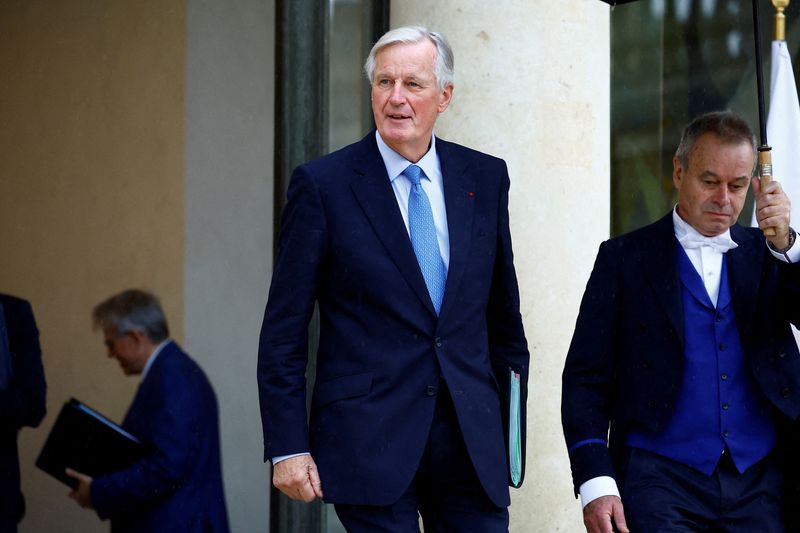
By Elizabeth Pineau and Michel Rose
PARIS (Reuters) - It's a mess, but it might just hold.
Despite looking like the most unstable French administration in recent history, despised by the left and propped up by the far-right, Prime Minister Michel Barnier's fragile minority government may last longer than many think, lawmakers and analysts told Reuters.
That's because Marine Le Pen's National Rally party, which could join forces with other disgruntled parties to topple the government at will, has no real interest in owning an even bigger mess that might damage its presidential hopes in 2027. It also faces an awkward corruption trial due to begin in Paris next week.
Meanwhile, Barnier has sought to placate Le Pen and neutralise the far-right's power over his right-wing team by appointing ministers who share RN anger on immigration and crime, leaving Le Pen's party with less to grumble about.
The left - still irked that it won the most seats in this summer's legislative election, only to see its prime ministerial candidate overlooked for the top job - says it will issue no-confidence motions against the government but knows it doesn't have the numbers on its own for those threats to count.
Say it softly but, after months of turmoil since Macron called the snap vote, a fragile stability now prevails.
"The French don't like chaos," senior RN lawmaker and party spokesman Laurent Jacobelli told Reuters. "We are not here to cause chaos, we are pragmatic."
Pouria Amirshahi, a Green party lawmaker who was part of the leftist alliance that won the most seats in this summer's vote, said the stability of the new government was based on "a sort of resignation" on the left, and the fact that "the RN has no interest in bringing down the government right away".
"They want to calmly prepare to govern," he said. The upcoming graft trial "will prevent Marine Le Pen from accelerating the upheaval that she is calling for but which she does not really want", he added.
On Monday, Le Pen, her party and 26 other RN members will go on trial in a Paris criminal court on charges of embezzling European Parliament funds.
Le Pen and the RN have denied any wrongdoing. If they are found guilty, they could face 10 years in prison and a 1 million euro fine, while also face being barred from office for up to five years. The trial is due to last seven weeks.
Jacobelli was calm about the impact the trial could have on perceptions of the RN, but confident the party would prevail.
"Obviously, this will be discussed at a time when we would prefer to talk about the problems and the future of the French," he told Reuters.
EARLY TEST
The upcoming 2025 budget bill, which needs to reach lawmakers by mid-October at the latest, provides the first real test of Barnier's government.
It's politically toxic. New Finance Minister Antoine Armand and Budget Minister Laurent Saint-Martin must find billions of euros in spending cuts and tax increases to close a bigger-than-expected deficit.
Although discussions will be tough, especially as France is under pressure from the EU and bond markets, the RN has little reason to shut down France by blocking the bill, experts said.
"They're looking for respectability so, for them, playing a partner role in the making of the budget is very clearly part of their electoral strategy," said Christopher Dembik, an economist with Swiss bank Pictet, who believes the government will survive until summer at least.
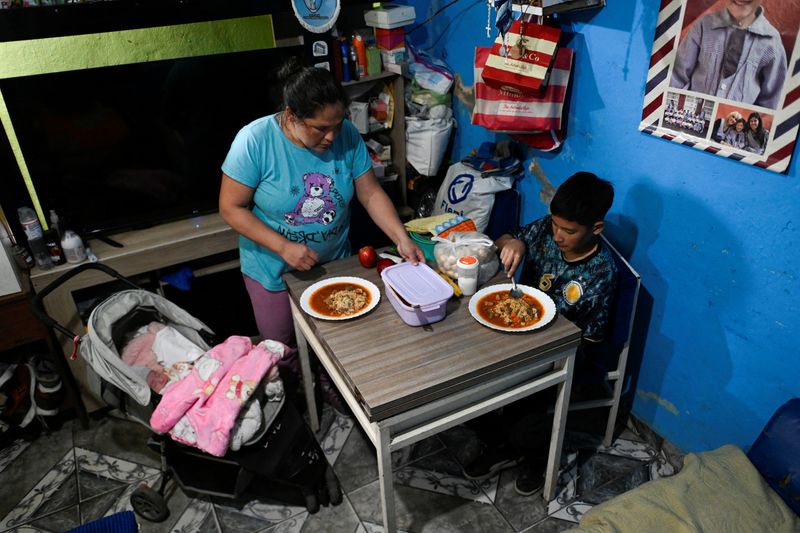
BUENOS AIRES (Reuters) -Argentina's poverty rate soared to almost 53% in the first half of the year, official data released on Thursday showed, the first hard evidence of the painful impact of libertarian President Javier Milei's tough austerity measures.
That marked a steep jump from 41.7% at the end of last year and more than double the 26% just seven years ago, underscoring the severe cost to regular Argentines of repeated economic crises that have hammered the South American nation.
The data underscores how Milei's spending cuts, aimed at overturning a deep fiscal deficit, have caused major short-term pain. The country is in a deep recession and inflation remains in triple digits, though there are signs things are improving.
"Since this government came to power, jobs have dropped away," said Irma Casal, a 53-year-old in Buenos Aires, who works three shifts as a garbage recycler, cardboard collector and bricklayer, but still struggles to stay afloat.
"We work twice as hard for less and we have to keep going."
Agustin Salvia, director of the UCA's Observatory, said that there was a significant impact at the start of the year from Milei's policies. However, there had been signs of an improvement recently, he added.
"If you look at the whole story, it shows a deterioration in the first quarter. That situation has since started to ease," he said.
Argentina's government has cut some welfare programs and reduced support to soup kitchens, but argues that it has also expanded two key welfare programs, the Universal Child Allowance and a Food Card program, giving direct support to families.
"Any level of poverty is horrendous," presidential spokesman Manuel Adorni said in a daily press conference on Thursday, blaming mismanagement by previous governments for leaving economic "bombs" that Milei was now trying to deactivate.
"We are doing everything, everything so that this situation changes."
Milei's spending cuts have been cheered by markets and investors for helping right the state's finances after years of deficits, but have pushed the country into a recession, despite signs the economy could now be bottoming out.
The Catholic University of Argentina's (UCA) observatory had estimated the poverty rate soared to 55.5% in the first quarter of the year before easing to 49.4% in the second quarter, giving a 52% average for the first six months of this year.
'ANY LEVEL OF POVERTY IS HORRENDOUS'

By Elisa Anzolin and Mimosa Spencer
MILAN/PARIS (Reuters) -Moncler's Chairman and CEO Remo Ruffini is tightening his control of the outerwear specialist after striking a deal with LVMH, which will partner with Ruffini to fund an expanded investment in the Italian company.
The deal also strengthens French group LVMH's dominance of the global luxury sector. Milan-based Moncler, one of the industry's biggest success stories in recent years, had been seen as a potential acquisition target or merger candidate for rival luxury groups seeking to expand.
Under the deal announced late on Thursday, LVMH purchased a 10% stake in Double R, the investment vehicle controlled by the CEO's Ruffini Partecipazioni Holding, which currently has a 15.8% stake in Moncler.
Double R will increase its stake in Moncler up to 18.5% over the next 18 months, thanks to the funding provided by LVMH that will increase its investment in Double R up to 22%, Ruffini Partecipazioni Holding and LVMH said in a statement.
Over the last nine months, two investors in Double R had exited the vehicle and were paid with Moncler shares, which had reduced Ruffini's control of the company.
The partnership with LVMH will reinforce Ruffini's position as the largest shareholder of Moncler, the companies said.
LVMH will gain the right to appoint two board members to Double R, solely controlled by Ruffini, as well as a director on Moncler's board.
Investors have grown jittery about a slowdown in the luxury sector, particularly weakness in the key Chinese market, hit by slowing economic growth and a property crisis.
But Moncler has proven resilient, with 11% revenue growth in the first half of the year, thanks to double-digit growth in Asia.

